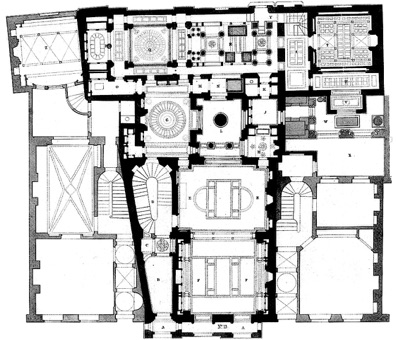
Box 7: The Invention of Virtual Thickness
Page 27
Box 7: The Invention of Virtual Thickness
Page 28
The early use of hollowed-out space, carved from conceptual thickness, is evident in the three shaped rooms at the rear of Lord Burlington's Palladian plan for Chiswick House, 1729, where the corners of the rounded Gallery rooms are effectively disengaged from the perimeter walls of the building by subsidiary spaces. (B7-a).
However, it is the work of John Soane that truly represents the first realization of negative space, beginning with the vaulted ceiling volumes in The Bank of England between 1788 and 1833, and epitomized by the elaborate spaces of his own house in 1811. Soane is the starting point toward an architecture which actively occupies the space of the wall. This is nowhere more apparent than in the facade of his own house. The facade itself, which was added as a layer in front of the existing building as a thick, double wall is a contrived thickness, conceived as a solid, but completely occupied by a void. A constructed habitable poché (B7-b,c).
The John Soane House
The consequences of this are clearly revealed in the upstairs sitting room (B7-d,e) where the room in plan is shaped independently from the surface of the facade and related only through a thick wall of windows. This is a plan condition similar to the vestibule and facade wall of the Palazzo Barberini in which a curved room is juxtaposed against a flat exterior, but at Soane's house the thickness and solidity of the in-between wall is not literal but a more illusory and incomplete conception. The mass of the wall has been opened up.
Sketch of interior sitting room, Soane House.
Chiswick House, Chiswick, England, Lord Burlington, 1729.
Plan of Upstairs Sitting Room, Lincoln's Inn Fields, showing projecting thick facade, Sir John Soane, 1812-13.
Facade of Soane Museum and sketch of “thick facade” adjacent to sitting room.
View looking into “thick facade” from sitting room.
Illusion of wall defined by thin construction elements.

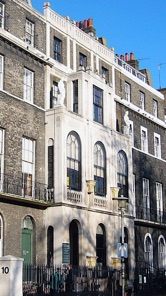
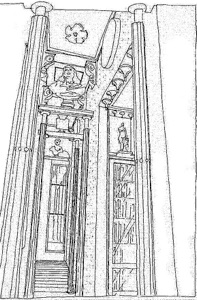
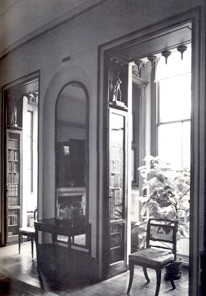
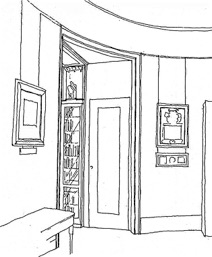
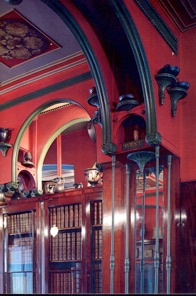
This space, however, is not empty, but is articulated to reflect and describe the spatial connection between the window on the facade and the openings in the room. These demarcations form a tiny series of spaces which are parallel in sequence to the sitting room. These spaces have a miniature architecture all their own, with columns, niches, vaults, and statues, designed so that the details inscribe the space with geometry and scale, asserting a density and sense of enclosure to each part, which completely contrasts with the sparseness of the main room. Because of this, the space of the wall is identified — it exists. One feels as within a thick form, rather than simply in between two separate walls or planes.
Although Soane's negative space is tentatively formed, it is a subtle phenomenon rather than a literal disguise of mass, as in the Palazzo Barberini. Here, it promotes a multiplicity of interrelated, but separately defined spaces, yet also explores the technological capacity to make things thin. Old perceptions and a new type of construction appear together as Soane exploits both thinness and thickness at the same time (B7-f,g). The compositional precedents of volumetric space are incorporated into a new situation which does not use massive walls. The illusion of the wall remains but it is hollowed out and its presence is re-established by the specificity of its own interior space. Nothing is lost and a great deal is gained.
John Soane explored other uses of negative space in the house, particularly in unique modulations of the section, where he invented a form of ceiling using false domes and vaults to create the same kind of thick double layered space overhead as in plan (B7-h). This vertical formation of space is one of the most difficult things to accomplish today because of prejudice in favor of the honest treatment of structure. Yet even at that time, Soane's vaults were an ambiguous spatial vision which contradicted the real construction. It was, in effect, the invention of a free section — spatial volumes formed independently of structural elements.
These interior vaults and domes were not the actual structure any more than they had been, for example, in a Palladian interior, but Soane exposes this condition and consciously incorporates the space of the attic into the room. The many variations of negative space as free section are clearly demonstrated in the vaulted rooms of the Bank of England, in his own dining room, at the gate house of Chelsea Hospital, and at the Dulwich Picture Gallery.
Soane's negative space is particularly evocative because its transparent multiple readings, alluding to mass with thin materials of construction, demonstrate the feasibility of combining volumetric space with modern technology. It is also an attitude which accommodates a contrasting and flexible range of scales, between large, open, simple volumes, and small, closed, intricate spaces. In the plan to the right, note the breakfast room with the round ceiling pattern (blue circle) and observe the surrounding layers and slots of space (B7-i).
Plan of first floor, Soane Museum, note the breakfast room next to an outdoor court at the heart of the plan.
B7-h Section, Soane Museum, through the rear sequence of rooms.
Click image for larger view
Click image for larger view



The original version of this article was published in
The Harvard Architectural Review
a publication of students at the Graduate School of Design
Harvard University
“Beyond the Modern Movement”
Volume 1 Spring 1980
Editors’ Note
As architects have become increasingly concerned with the emotional and cultural effects of their designs, they have rejected the ambiguous, abstract spatial configurations of Modern Movement architecture in favor of the making of 'places' which are enclosed and well-defined. The typical Miesian house consisted of an organization that was highly regarded because it held true to a simple diagram; space was left free and unencumbered whenever possible. By contrast, contemporary designers are rediscovering the value of enclosure and definition of architectural space, of making space readable through the use of formal circulation and sequential, articulated rooms.
In poetic language, Steven Peterson contrasts modern and traditional space through the effects of enclosure, opening, and partition. Implicit in this argument is a re-affirmation of pre-modern ideas, and a re-integration of the architectural tools of ornament, symmetry and poché. The author speaks in the language of the designer, presenting the means for forming enclosure and containing spaces in specific, architectonic terms. The message is presented so strongly that it begins to be reminiscent of the oversimplifications inherited from the Modern Movement itself. One might question, in fact, whether a new role for design is being suggested, or just proof that the architect’s palette should be broadened and revitalized through recovery of long disused techniques.
In any case, the striving expressed here for greater involvement in molding architecture and architectural space, through methods previously considered regressive by Modern Movement designers, exemplifies the investigations which a generation of architects are occupied with today. They are searching for ways to make architecture mean more than shelter through investigating its forms: the thickness of a wall, the shape of a space, the nature of enclosure.
Page 29
B7-a
B7-b,c
B7-d
B7-e
B7-f
B7-g
B7-i

